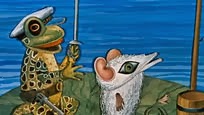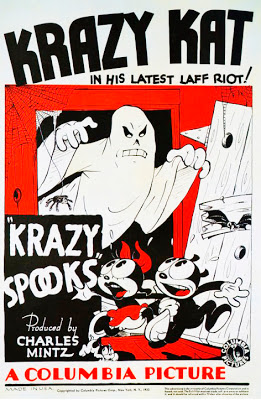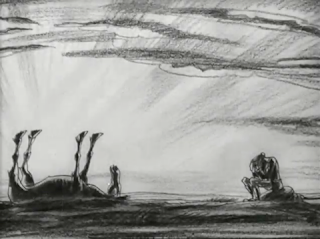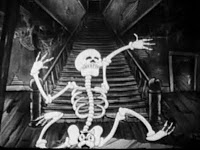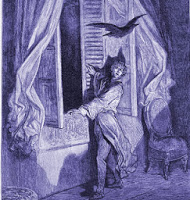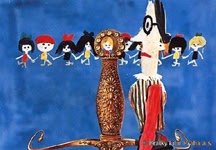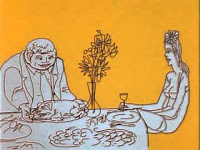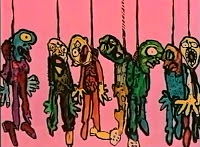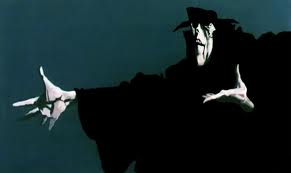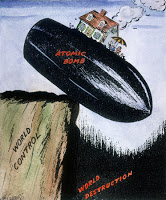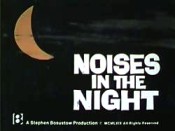Oddball Films presents Creepy Cartoons - The Dark Side of Animation, a program of strange, dark, and unsettling animation from around the world. Cartoons are generally thought of as light entertainment for children, but the medium allows the viewer to explore dark and surreal worlds and subject matter at a two-dimensional distance. The devilish delights of this program include a pencil-drawn version of a 19th century British folk song Widdecombe Fair (1948) about an ill-fated trip to the fair on an old grey mare for Tom Pierce and a dozen of his closest friends. Comic strip Krazy Kat comes back to the big screen to fight off ghosts and other haunts, while his puppy fights with a skeleton in the silly romp Krazy Kat in Krazy Spooks(1933). Optical printing bring Gustave Dore's engraving of Poe's The Raven to haunting life. Adorable bunny rabbits teach us a lesson about gun-violence and racial inequality in the justice system in The Punishment Fits the Crime (1972). Looney Tunes animator Paul Julian creates a dark and surreal vision of Maurice Ogden's poem The Hangman (1964). The Czechs bring us two pieces, the clever cutout animation The Sword (1967) and Bretislav Pojar's tale of global annihilation, Boom (1979). Peter Foldes and the National Film Board of Canada create a nightmarish vision of excess in the early computer animated stunner Hunger (1974). And because we can't get enough of them, we will be bringing back two of our all-time favorite cartoons of the collection, Bruno Bozzetto's dark and sexy examination of the working man's Freudian subconscious, Ego (1970) and Betty Boop teaming up with Cab Calloway for one spooky night in Minnie the Moocher (1932). Plus, early birds will be treated to the Di$ney Halloween classic The Legend of Sleepy Hollow (1949).
Date: Friday, November 1st, 2013 at 8:00PM.
Venue: Oddball Films, 275 Capp Street, San Francisco
Admission: $10.00, Limited Seating, RSVP to: 415-558-8117 or RSVP@oddballfilm.com
Featuring:
Widdecombe Fair (B+W, 1948)
Based on the Devon folk song, first published circa 1889, this pencil-drawn tale tells of Tom Pierce, who borrows his neighbor's old grey mare to take to the fair, only to load the poor creature with "Bill Brewer, Jan Stewer, Peter Gurney, Peter Davy, Dan'l Whiddon, Harry Hawke, Old Uncle Tom Cobley and all," eventually killing the horse and all it's many passengers.
Krazy Kat in Krazy Spooks (B+W, 1933)
Krazy Kat jumps back to the screen from the comic strip, (looking a lot like one Mr. M. Mouse) to battle ghosts, skeletons and gorillas in this silly short. Krazy Kat and his sweetheart (with a curiously tiny puppy in tow), head into a haunted house and squeal at everything! The puppy tangles with a skeleton to adorable and hilarious effect, but when the danger becomes real, will they be able to fight off a Poe-esque twist?
The Raven (Color, 1978)
Don't be deterred by any negative associations you may have with the idea of a Raven adaptation (after, I'd guess, the recent one with John Cusack). A look at this elegant, experimental animation, directed by Lewis Jacobs, will breathe new life into Poe's classic deathful tale, editing Gustave Dore's 19th century engravings to stunning effect, with brilliant near-psychedelic coloring and an appropriately somber voice-over reading of the poem.
The Punishment Fits the Crime (Color, 1972)
Adorable bunny rabbits tackle the issue of racial inequality within the criminal justice system, in a fuzzy, light-hearted kind of way. With the outbreak of bunny-on-bunny violence, you will never think of bunnies in the same way again. With artwork by children’s illustrator, Steven Kellogg.
The Hangman (Color, 1964)
Paul Julian, previously known as an animator for Warner Bros' Looney Tunes, directs this haunting adaptation of Maurice Ogden's poem of the same name. A mysterious hangman comes to a small town, taking upon himself the responsibilities of town judge, jury, and executioner, but rather than questioning the stranger's arbitrary sentencing, the town's residents stay satisfied with their own well being, and look idly on as their community dwindles and their neighbors, one-by-one, face the noose-but might they too be beckoned by the hangman? Surreal in its visual style with long shadows and sharp color contrasts, and made all the more unsettling by an eerie jazzy sort of score. Is it about the Holocaust, playground bullies, McCarthyism? Discussion when the lights go up.
The global arms race as animated by the legendary Bretislav Pojar (Balablok). Takes a look at the history of aggression and the theory that might makes right. By extension, it carries us into the atomic and missile age, postulating various scenarios for planetary self-destruction, both planned and accidental. Without narration, using only sound effects and music, the film asks the question: is this THE END? Awarded the Grand Jury Prize at Cannes in 1979.
The Sword (Color, 1967)
This clever Czech cutout animation is short and er… to the point, The Sword is an allegory on the ignorance of people who enjoy their life to those who are suffering or dying at the very same instant.
Hunger (Color, 1973)
At an extremely rapid pace, images dissolve, move, morph and/or reappear into things or objects that become more and more exaggerated and absurd in this witty and disturbing cartoon by Hungarian director Peter Foldes. One of the first computer-generated films, this Jury Prize winner at the Cannes Film Festival and Academy Award Nominee is a satire focusing on the self-indulgence that plagues our ‘hungry’ world, and depicts a man as he continues to eat, and eat, and eat!
Screened recently here as part of the Valentine's show, this brilliant animation by Italy’s Bruno Bozzetto (of the cult favorite Mr. Rossi series) demands a re-screening. Opens with traditional comic strip-style animation until the factory-working family man goes to sleep and unleashes his subconscious thoughts, sending him into a battleground of situations. Utilizes a number of animation styles including optical printing and pop art imagery. Features a wild soundtrack by the ultra-lounge master Franco Godi…
Minnie The Moocher (1931, Dave Fleischer, B+W, 8 minutes)
All time classic featuring Cab Calloway and his Orchestra, Betty Boop and Bimbo. A happening song with thinly veiled sex and drug references: Minnie she meets up with a pimp, the king of Sweden, who gives her “somethin she was needin'”…then gets caught up with a pot headed coke-sniffing junkie who teaches her how to "kick the gong" (mainline heroin). After a fight with her folks, Miss Boop runs away from home, and all its surreal comforts -- and takes Bimbo with her! Taking refuge in a hollow of a tree, they encounter hostly beings! Cab Calloway and his band provide most of the short's score appear in a live-action introduction. The thirty-second live-action segment is the earliest-known film footage of Calloway, whose gyrations were rotoscoped for the spooky, singing walrus.
Noises In The Night (Color, 1969)
Beautiful and sweet animation from (UPA founder) Stephen Bosustow Productions. Little Sherri hears strange noises at bedtime and wakes up the entire household...night after night after night. Her parents attempt to persuade her that night noises are usually made by familiar things...or are they?
Mr. Frog Went A-Courtin' (Color, 1974)
A gorgeous animation that truly gets to the heart of the inter-species strangeness that is the folk favorite “Froggie Goes A-Courtin'”. From the National Film Board of Canada, directed by Evelyn Lambart, and sung by Derek Lamb. A frequent collaborator with Norman McLaren, Evelyn Lambert forged a distinct whimsical style with dark undertones utilizing cutouts.
